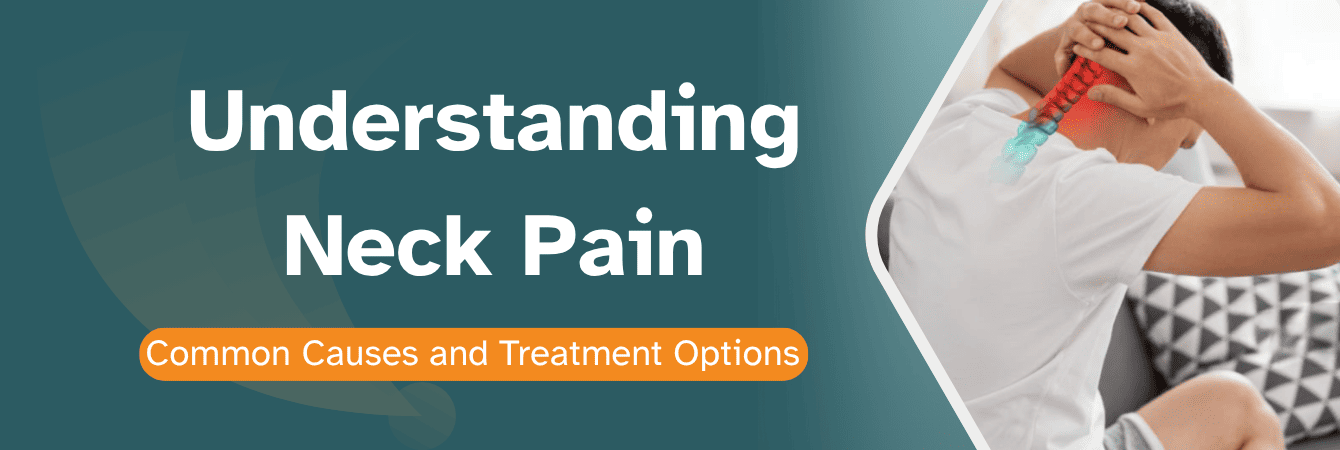Neck Pain: 5 Common Causes and Neck Pain Treatment Options
- October 3, 2025
- Abrol Hospital
How Neck Pain is occurs?
Neck pain typically arises in the cervical spine, which consists of seven small vertebrae supporting the head and enabling movement. These vertebrae are surrounded by muscles, ligaments, and nerves—all of which can be affected by injury, strain, or wear and tear. Neck pain may stay localized or radiate to the shoulders, arms, or even upper back, depending on the cause. Because the neck is both mobile and responsible for bearing the weight of your head, it’s especially vulnerable to stress and injury. hether it’s a dull ache or a sharp, stabbing sensation, neck discomfort makes simple activities like turning your head or working at your desk feel like a chore.
5 Common Causes of Neck Pain
1. Poor Posture
Let’s face it—we’re all guilty of slouching. Whether it’s staring down at our phones, working long hours at a computer, or binge-watching Netflix, poor posture is now a leading cause of chronic neck pain. The human head weighs roughly 10 to 12 pounds, but when you tilt it forward, the pressure on the neck increases dramatically—up to 60 pounds! That kind of strain over time can lead to “text neck,” a modern-day syndrome where bad posture causes muscle fatigue, joint strain, and even disc problems.
If you notice pain at the base of your skull or upper shoulders after screen time, chances are posture is the culprit. Correcting it through ergonomics and regular movement can be a game-changer.
How it happens:
Slouching weakens neck support muscles
Head leaning forward shifts weight and pressure
Over time, this becomes chronic and painful
2. Muscle Strain
Muscle strain is one of the most common and straightforward causes of neck pain. It usually results from overuse or awkward positioning. Think about sleeping in a strange position, holding your phone between your ear and shoulder, or even carrying a heavy bag on one side. These activities can overwork certain muscles and cause them to tighten or spasm.
Even something as simple as emotional stress can trigger muscle tension. You might not even realize you’re clenching your neck and shoulder muscles until they start to hurt. Unlike more serious injuries, muscle strains usually resolve with rest and gentle stretching, but recurring strains should be taken seriously to prevent long-term damage.
Common triggers:
Sleeping without neck support
Repetitive motion or lifting
Spending too long in one position
3. Herniated or Bulging Discs
Between each vertebra in your spine is a small disc filled with gel-like material. These discs act as cushions and help absorb shock. But sometimes, due to injury or degeneration, these discs can bulge or rupture—pressing on nearby nerves and causing pain.
When this happens in the neck, it can lead to cervical radiculopathy, where pain radiates from the neck down into the shoulders, arms, or hands. You might also experience tingling, numbness, or weakness. Herniated discs can be caused by trauma, aging, or even poor posture over time. Treatment often includes physical therapy, medications, and in severe cases, surgical intervention.
Symptoms include:
Radiating pain into shoulders or arms
Numbness or weakness in limbs
Pain that worsens with movement
4. Degenerative Disc Disease
As we age, our spinal discs naturally begin to dry out and lose flexibility. This is called degenerative disc disease, and it’s a leading cause of chronic neck pain in older adults. Over time, the lack of cushioning between vertebrae can lead to inflammation, bone spurs, and nerve compression.
People with this condition often experience a constant, dull ache in the neck that flares up during activity or after prolonged sitting. While degenerative disc disease is technically a natural part of aging, certain lifestyle factors—like smoking, poor posture, or lack of exercise—can accelerate the process. Managing this condition often requires a multi-pronged approach, including physical therapy, medication, and lifestyle changes.
Why it happens:
Loss of disc fluid and elasticity
Bones rubbing together
Formation of bone spurs
5. Injuries and Accidents
Neck injuries from car accidents, falls, or sports activities can cause sudden and severe neck pain. One of the most well-known injuries is whiplash, which occurs when the head is forcefully whipped forward and then backward, straining the soft tissues in the neck. Symptoms may not appear right away and can include neck stiffness, headaches, dizziness, and fatigue.
Pain that appears hours or days after injury
Limited neck movement
Headaches and dizziness
Other Contributing Factors
While these five are the big ones, neck pain can also be caused by:
Stress and anxiety – which tighten your muscles
Health conditions – like arthritis or infections
Obesity – extra weight strains the spine
Neck Pain Treatment Options
1. Home Remedies
The first step in treating mild neck pain is usually self-care. Apply ice packs during the first 48 hours to reduce inflammation. After that, switch to heat to loosen stiff muscles. Gentle neck stretches and light movements can help prevent stiffness from setting in.
It’s crucial to avoid bed rest for extended periods. While it may seem like the best way to heal, lying still for too long can actually slow recovery and cause muscles to weaken.
2. Physical Therapy
Physical therapists can teach you specific exercises to strengthen the neck, improve posture, and reduce pain. They may also use techniques like ultrasound, electrical stimulation, or manual therapy to improve mobility.
Consistent physical therapy is especially effective for posture-related pain or recovery from injuries like whiplash. Over time, you’ll not only heal but also learn how to prevent future issues.
3. Medications
Over-the-counter pain relievers like ibuprofen or acetaminophen are often the first line of defense. For more severe pain, doctors may prescribe muscle relaxants, anti-inflammatory medications, or even short courses of opioids (although these are rarely used long-term due to side effects and addiction risk).
Topical creams with menthol or capsaicin can also provide localized relief.
4. Chiropractic Care
Chiropractors perform spinal adjustments that help realign your vertebrae, relieving pressure on nerves and improving overall function. While some people swear by it, others may not benefit—especially those with severe disc issues or spinal instability.
If you choose chiropractic care, make sure to go to a certified, experienced professional who understands your medical history.
5. Massage Therapy
Massage is excellent for relieving tension in the neck and shoulders. It increases blood flow, reduces muscle stiffness, and helps you relax. Regular sessions can be especially helpful for stress-related or posture-induced neck pain.
However, massage isn’t recommended if you have an active injury like a herniated disc or spinal instability. Always consult with a healthcare provider before starting treatment.
Lifestyle Tips for Preventing Neck Pain
Prevention is just as important as treatment. Here are simple yet effective habits to reduce your risk:
Adjust your workstation so your screen is at eye level
Use a supportive pillow that keeps your neck aligned
Take frequent breaks from sitting or screen time
Stretch your neck and shoulders daily
Exercise regularly to maintain muscle strength and flexibility
These habits may seem small, but they add up in a big way over time.
🩺 Struggling with Neck, Neuro, or Spine Pain? We’re Here to Help!
Don’t let pain hold you back from living your best life. At Abrol Hospital, Gurdaspur, our experienced team of neurologists, spine specialists, and orthopedic experts offers personalized care using advanced diagnostic tools and effective treatment options.
✅ Comprehensive Neck, Neuro & Spine Care
✅ Expert Consultations & Accurate Diagnosis
✅ Latest Non-Surgical & Surgical Treatments

FAQs About Neck Pain Causes & Treatment Options
If your pain doesn’t improve after a week, or if it radiates to your arms or legs, comes with numbness, or follows an accident—see a doctor immediately.
Absolutely. Emotional stress tightens your muscles, especially around your neck and shoulders. Over time, this tension can lead to chronic pain.
For quick relief, try ice or heat packs, OTC pain relievers, gentle stretching, and rest. Avoid heavy lifting or sudden movements.
They can be, when performed by a licensed chiropractor. However, they’re not suitable for everyone, especially those with spinal instability or disc issues.

